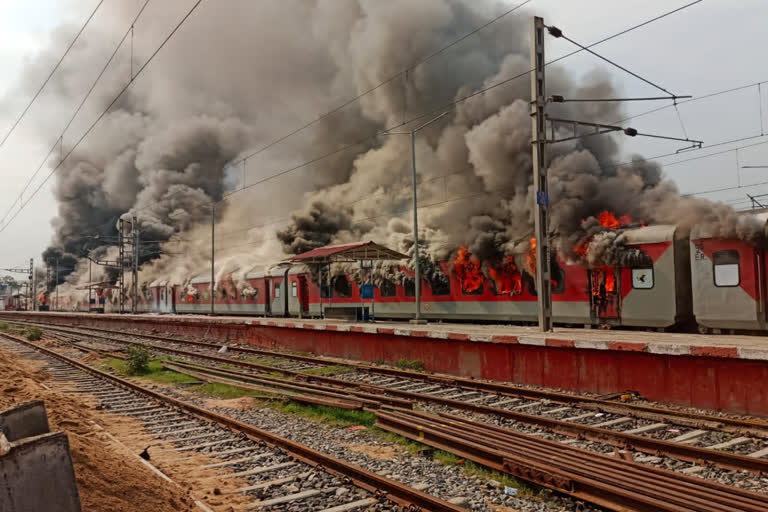New Delhi: With nationwide protests continuing against the recently-announced ‘Agnipath’ recruitment scheme for the military, the top brass of the defence ministry and the three services of the armed forces summoned another hurriedly-convened meeting of journalists on Sunday afternoon in the national capital’s South Block which houses the ministry of defence.
In the meeting where top officials of the Department of Military Affairs (DMA), the Army, Navy and the IAF were fielded, the government continued with its resolute defence of the recruitment scheme that radically alters the mode of enlisting and service conditions for India’s 14-lakh strong military. But along with the defence of the new recruitment policy, the government went strongly for the offensive with strong words for those who indulged in violence, vandalism and arson.
Lt Gen Anil Puri represented the DMA, while the Army, Navy and the IAF were represented by Lt Gen Bansi Ponappa, Vice Admiral Dinesh Tripathi and Air Marshall S K Jha respectively. Leading the charge and declaring the government’s intent, Lt General Puri, additional secretary, DMA, said those who indulged in violence, arson and vandalism will be easily identified from videos and pictures, linked with their ‘Aadhaar’ numbers, and then picked up by the police.
“They will not reach the training centres… Indian Army's foundation is in the discipline. No space for arson or vandalism. Every individual will need to give a certificate that they were not part of any protest or vandalism. Police verification is 100%, no one can join without that,” Lt Gen Puri said. Warning the youth not to waste time in protests and instead prepare for the recruitment, he said a period of 45-60 days has been given to prepare for the physical tests. On the other hand, if any FIR has been lodged against any youth, he or she will be barred.
The officer laid down the painstaking two-year-long process of careful deliberation and discussion adding that the protests were not something that was anticipated. The military officers also laid down a timetable of executing the first ‘Agnipath’ recruitment. While the registration of the first batch of IAF ‘Agniveers’ will start on June 24, the online examination process would begin from July 24, while the first batch would be enrolled by December 2022 and training would commence by December 30, 2022.
Also read: Train stations, highways turn into battleground as youth fury over 'Agnipath' singes nation
The Army will issue a draft notification on Monday (June 20) and subsequent notifications will be issued by various recruitment units of the force from July 1 onwards. The Navy will come out with a guideline by June 25 and the first ‘Agniveer’ batch of recruits, which will include women, will begin training by November 21. Already the government has announced several measures to address issues that have become a cause of concern among aspirants, including the proposal to reserve 10 per cent of the job vacancies for recruitment in Central Armed Police Forces (CAPFs) and Assam Rifles and various other organizations, increasing the upper age limit from 21 years to 23 years for the 2022 recruitment cycle, etc.
Several state governments and other ministries have also come out and announced various supportive measures for the ‘Agniveers’ who would not get inducted into the armed forces. Along with the theaterisation and integration effort, setting up of the office of the Chief of Defence Staff (CDS), and the corporatization and restructuring of the Ordnance Factory Boards (OFBs), the ‘Agnipath’ scheme is among the most radical military reform measures in the Indian military’s history.
The scheme was announced by defence minister Rajnath Singh and the three chiefs of the Army, Navy and IAF on July 14. Apparently deliberated and discussed for the last two years, the scheme changes the traditional recruitment system of picking the fighting men (and women) to populate the world’s second-largest military. What ‘Agnipath’ will do is to harness the peak fitness and dynamism of the youth aged between 17.5 to 21 years, and with one stroke bring down the average age profile of the Indian soldier from 32 to 26 years, shaving off six years.
Also read: 'Agnipath well thought out plan to fuel RSS ideology': Former union minister K Rehman Khan
Both the Kargil Review Committee (2000) and the Arun Singh Committee (1990) had said that the high average age profile of the Indian Armed Forces was “worrisome”. On completion of four years, one-fourth or 25% of the ‘Agniveers’ will be re-employed for 15 more years based on merit, their intent and the organizational requirement. The remaining three-fourths or 75% would be adequately compensated with an attractive retirement package called ‘Seva Nidhi’.
While the aspirant youth has been mainly troubled by the non-permanent nature of recruitment, the scheme has drawn considerable flak from military veterans on various grounds including that of leading to an under-trained, poorly motivated and inefficient military. It is understood that the scheme has also been necessitated by the inflating salary and pension bill of the military that has come at the cost of modernisation and acquisition of the latest weaponry.



